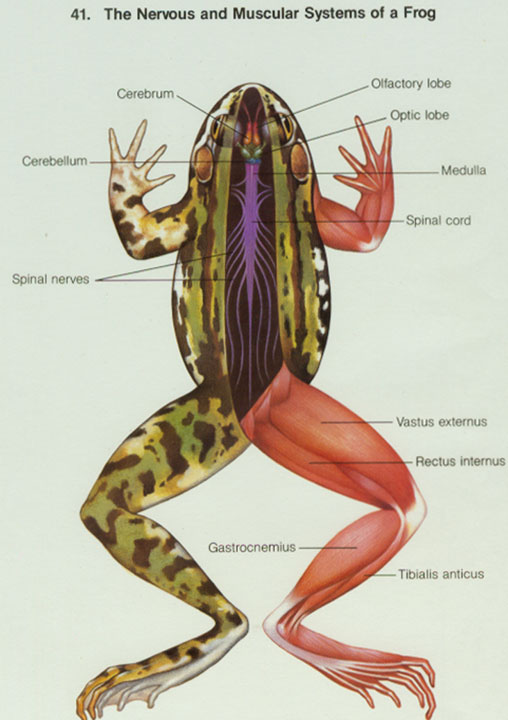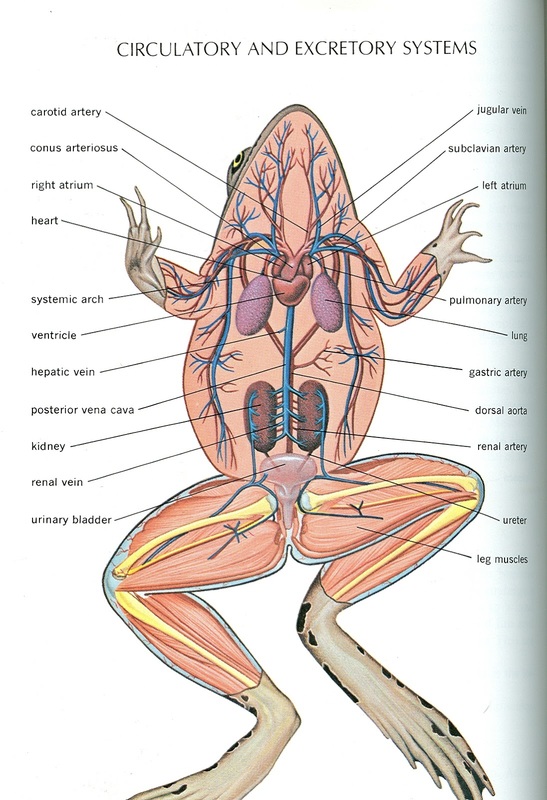Where Did the Frog Have the Most Muscle
For the frog heart temperature and heart rate are _______. From the lower leg of the grass frog Rana pipiens.

Information And Facts On The Anatomy Of Amphibians
In normal Ringers solution containing 25 mM-K the mean potassium flux in the toe.

. Now on to the Facts. The sinoatrial node is located _______. 12L o beyond which passive force increased exponentially with increasing length.
In normal Ringers solution containing 25 mM-K the. 3 The hairy frog is listed as Least Concern by the IUCN. What is the role of the wrist extensor in the forearm of the frog.
They can be removed from an organism intact with little loss of function. The heart beat is counted for 15 seconds noted and multiplied by 4. In the right atrial wall of the human heart.
Most of the work was concerned with a small muscle from the frogs foot the M. The Skeleton and Muscles. On the basis of the results obtained most of the drugs could be put into one of two main groups.
Muscle 4 After a short time LabScribe will appear on the computer screen with the Muscle 4 Settings. The sensitivity of completely denervated and the innervated end-plate regions of partially denervated frogs sartorius muscles to stimulation by drugs has been investigated. 1 These frogs are terrestrial spend most or all of their lives on the ground.
Relate this to the resting membrane potential of the cardiac muscle cell. Also muscle tissue can be taken from an organism without removing other non-contractile tissue. The frog has no ribs.
The deltoid muscle draws the arm of a frog forward. The muscle gets its name because each fiber has alternating dark and light stripes known as striations. The frogs body is supported and protected by a bony framework called the skeleton.
At Bologna Galvani learned physiological theories of animal motion that prevailed across Europe at the time. The muscles have also been greatly enlarged with the main leg muscles accounting for over 17 of the total mass of frogs. It originates on the pubis inserts on the tibiofibula and acts to extend the thigh and flex the shank.
Albrecht von Haller a Swiss-born anatomist who did most of his work in Germany popularised a doctrine that divided animals bodies into irritable parts muscles and sensible parts nerves. The effect of increasing the potassium ions caused the heart rate to decrease from 61 to 28 and with the increase of. The frog does not have a tail.
Of radioactive sodium and potassium in frog muscle fibres. Provide several possible explanations as to why our results have so much variability. How well did the results compare with your prediction.
A decrease in heart rate and eventually a temporary cessation of the heartbeat. In recent years fairly detailed information has been obtained on the physio-logical eventswhichoccur atthevertebrate neuromuscularjunction. The gracilis major 6 is a large muscle that partly covers adductor magnus.
Baseline Frog Heart Activity Control 1. Most of the work was concerned with a small muscle from the frogs foot the M. Most have smaller toe pads if any and little webbing.
This image shows a close-up view of some of the major muscles of the ventral surface of the frog thigh seen on the previous page. Excessive vagal stimulation of the heart will result in _______. Experiments in Frog Heart Physiology Activity.
The most muscle mass in a frog is in the hind legs. Experi-ments on frog and mammalian muscle have shown that the transmitter acetylcholine is released fromthe axonterminals in discrete multi-molecular packets and attention has been directed to the. Ground-dwelling frogs generally lack the adaptations of aquatic and arboreal frogs.
Some burrowing frogs such as Couchs spadefoot. Click and then and you should see a rhythmic deflection of the. 4 Like all amphibians the Wolverine frog breathes in part.
Wed expect time to fatigue would be very similar from muscles from the same frog. The human backbone has 24 vertebrae. IV but the fluxes in sartorius and abdominal muscles were also measured.
The chest of the frog is dissected from abdominal region until the cardiac is seen. This type of muscle makes up the majority of muscle including the pectoral or chest muscles of a frog the abdominal muscles and the arm muscles. The distinction between the two came as a result of some fairly.
The muscles did not develop passive force until stretched to relatively long lengths approx. Only nine vertebrae make up the frogs backbone or vertebral column. The frog is weakened by damaging its brain.
We found that frog muscles have a significantly higher L 20 than mammalian muscles p 00001. Methods are described for determining the absolute sizes of the inward and outward fluxes of radioactive sodium and potassium in frog muscle fibres. Based on this analysis we conclude that increased.
In May 2021 an image supposedly showing a frogs buttcheeks caused a stir on social media as internet users made various. What is the largest muscle in a frog. The skull is flat except for an expanded area that encases the small brain.
Describe the effect that increasing the potassium ions initially had on the heart in this activity. Measuring of Cardiac Muscle Contraction a. 2 This species has small lungs and the hairlike strands of skin give the male a better ability breathe while mating.
IV but the fluxes in sartorius and abdominal muscles were also measured. The drugs were tested on muscles isolated 12 to 39 days following denervation. Where does the frog have the most muscles.
Start the software settings AK204. Muscle tissues are relatively easy to work with experimentally.

Frog And Human Anatomy Comparison Ms Pearrow S 7th Grade Science

Frog And Human Anatomy Comparison Ms Pearrow S 7th Grade Science

Frog And Human Anatomy Comparison Ms Pearrow S 7th Grade Science
No comments for "Where Did the Frog Have the Most Muscle"
Post a Comment